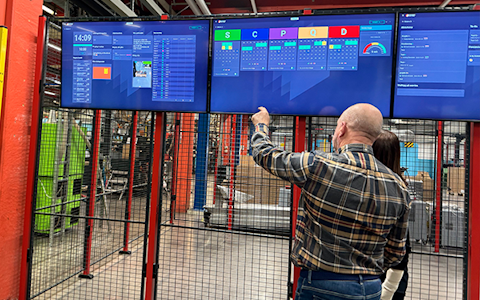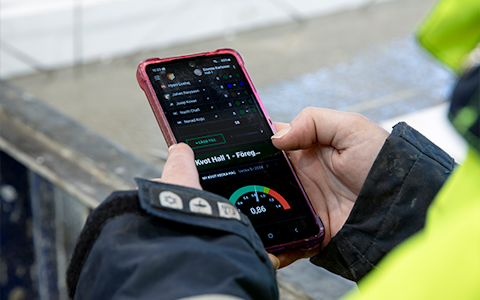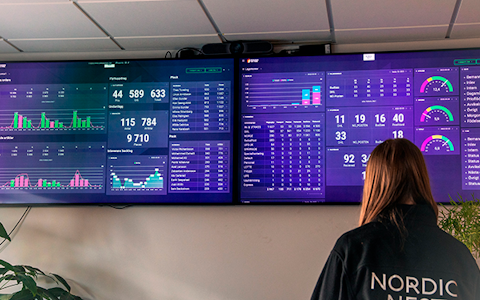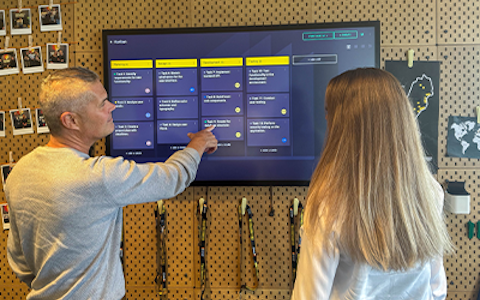
Digital dashboards that help you identify deviations and make the right decisions.

Capture your deviations and turn them into improvements

Continuous improvement, Kaizen boards, PDCA and other tools.

Improve key performance indicators within your specific focus areas with our SQCDP board.

Use the PDCA cycle as a tool to improve both quality and processes

Digital tools for 5S work, recurring audits, and a well-organized workplace.

Visualize KPIs and communicate effectively throughout the entire organization.

Basic project management and activity boards.

Kanban is a powerful method for visualizing, managing, and optimizing workflows.

Digital dashboards for takt time flow with takt time counter and stop time log.

Digital visitor registration provides full control over all planned and executed visits to your business.
Unlock the full potential of your digital daily management workflow with the Boards on Fire API - a powerful and flexible REST API designed to seamlessly integrate with your tools and applications.
Whether you're tracking key performance indicators (KPIs) or following up on specific metrics in Boards on Fire, our API allows you to seamlessly import data from the systems you already use. This ensures you have full control over all your data and can make informed decisions with real-time insights. From reading and creating to updating and deleting records, the Boards on Fire API empowers developers to easily build dynamic and scalable solutions that drive productivity and engagement through your whole organization.
Designed with simplicity and efficiency in mind, our API ensures you can quickly get up and running, whether you're a seasoned developer or just getting started. With tailored documentation per customer, and intuitive endpoints designed to meet your needs, you'll spend less time navigating complexities and more time to improve your business.
The Boards on Fire API is built on REST principles using JSON as content type. The full reference of the REST API is available in the format of Open API and is dynamically generated for each customer.
The API supports requests using the REST methods GET, POST, PUT, PATCH and DELETE.
The Boards on Fire API adapts to your specific setup in Boards on Fire, with dynamically generated documentation, ensuring endpoints are automatically created based on how you've configured your data sources and entities. Each endpoint in the API is tailored to reflect the fields and data types you’ve defined, providing a seamless and efficient way to interact with your flexible custom data structures.

All requests to Boards on Fire’s API are made through a single, reliable endpoint:
https://<your-boards-on-fire-url>/api
Replace <your-boards-on-fire-url> with the URL that host your instance of Boards on Fire.
Efficiency is at the heart of the Boards on Fire API. We use pagination to return data in smaller, manageable pages, ensuring faster response times and preventing overload. Whether you're working with thousands or millions of records, our API handles it smoothly.
The Boards on Fire API is built to handle large-scale data imports effortlessly. Whether you're managing vast amounts of data or need to make bulk updates, our API's powerful bulk operations allow you to work smarter, not harder. With support for upsert functionality, available for both data sources and entities, you can easily import or update large data sets in one go, ensuring that your records stay up-to-date without the need for multiple requests.
To maintain optimal performance, the Boards on Fire API employs rate limiting. Should your request volume exceed the set limits, you'll receive an HTTP 429 status (Too Many Requests). No need to worry, though—we recommend implementing a retry strategy, so your app keeps running seamlessly without missing a single KPI.
At Boards on Fire, we make authentication both secure and customizable. For each API client you create in Boards on Fire you can create API keys, providing you with full control over access. You decide the expiration time for each key, ensuring the right balance between security and convenience for your workflow.
For every API request, simply include your API key in the request header, and you're good to go. This streamlined process allows you to quickly authenticate and start building without hassle, while maintaining the highest levels of security for your data.
API Keys best practices
Free web demo